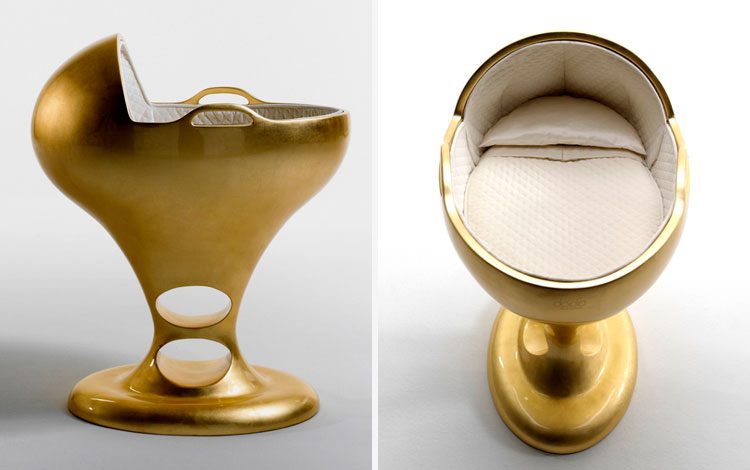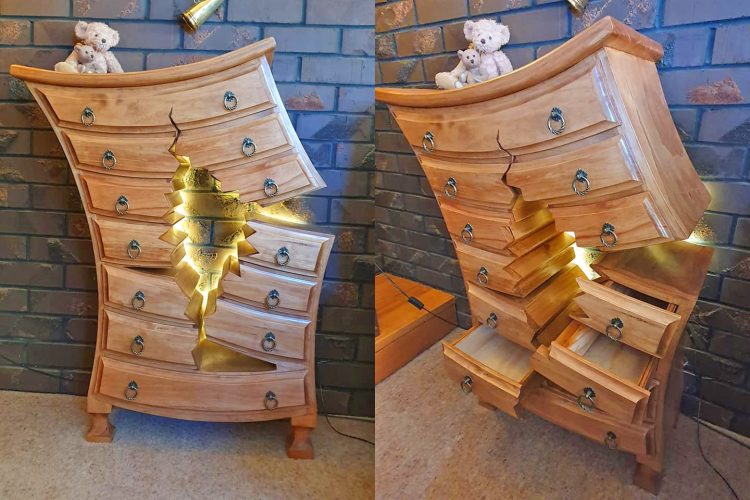Plufl – The World’s First Dog Bed for Humans

Inspired by the comfort of the classic dog bed, a couple of university students designed Plufl, the world’s first dog bed for humans. If you’re thinking that the Plufl is just an oversized dog bed, you’re technically right, but according to its creators, University of British Columbia students Noah Silverman and Yuki Kinoshita, it’s also […]
This Company Specializes in Opulent Baby Furniture and Accessories

If you want to offer your baby the best things money can buy, starting with only the world’s most luxurious cribs, baby bottles and even pacifiers, you need to check out Spanish design company Suommo. There are plenty of companies that sell premium baby products, but Spanish design studio Suommo is on a whole different […]
Retired Carpenter Goes Viral for His Whimsical Yet Functional Furniture

Warped or cracked furniture isn’t ideal, unless it’s that way by design, which is exactly what makes the whimsical cabinets of Henk Verhoeff so special. The retired carpenter from Auckland, in New Zealand, went viral the other day, after his daughter started posting pictures of his amazing wooden cabinets on Facebook. At first glance, they […]
UK Company Is Growing Furniture by Molding Trees into Chairs, Tables or Lamps
Money might not grow on trees, but it seems that furniture does! Gavin Munro, a UK-based designer, has come up with a brilliant alternative to chopping beautiful trees and converting them into furniture. He simply molds young saplings to take the shape of any piece of furniture he wants. Once matured, the trees are ready to be […]
Couples Therapist Has Patients Assemble IKEA Furniture to Solve Relationship Problems

A California therapist is helping couples resolve their relationship issues in the most unusual way – by having them assemble IKEA furniture. The experience, she believes, is so frustrating that it might actually bring couples closer to each other! “The store literally becomes a map of a relationship nightmare,” licensed psychologist Ramani Durvasula explained. “Walking […]
English Designer Creates Furniture That Looks and Feels Like Human Skin

Gigi Barker, a British furniture designer and owner of Studio 9191, has come up with a new range of seating that looks and feels a lot like the human body. The seats are designed to mimic bulbous, podgy human flesh. And they’re oddly comforting, as Gigi’s customers reluctantly admit. Although the seats are made of leather […]
The Do Hit Chair – A Smashable Piece of Furniture Worth $8,500

Furniture doesn’t come much more customizable than the Do Hit Chair from Droog Design. For the modest price of €6,553 ($8,500) you get a stainless steel cube and a sledgehammer to shape it into the chair of your dreams. Created by Dutch designer Marijn van der Poll caused quite a lot of controversy when it was […]
World’s Bounciest Chair Is Made from 65,000 Rubber Bands

It might look like just a colorful art piece, but Justin Moeller’s rubber band chair is functional piece of furniture able to sustain a grown man’s weight. The young industrial designer created the unique in 2011, by hand, from over 65,000 rubber bands. Justin Moeller was in his final year at the Appalachian State University, in […]
Designer Creates Furniture from Thousands of Puzzle Pieces

Devon-based artist Rupert McKelvie has used thousands of discarded puzzle pieces to create a stylish table complete with a lamp. If you’re wondering what inspired the 27-year-old artist to create pieces of furniture from a weird medium like broken puzzles, it was the frustration of spending hours of patient labor assembling a puzzle, only to […]
Designer Makes Furniture from Discarded Electronics

Benjamin Rollins Caldwell of BRC Design recycles old computer components by using them to create original pieces of furniture. Discarded electronics are a major problem for the environment, and there’s no better example than China’s Guiyu electronics waste site, but some people come up with original ideas that make recycling them look easy and cool. […]
World’s Most Expensive and Amazing Children’s Beds

Every parent wants the best for his child, but would you pay the price of a luxury car to get them the fantasy bed they’ve always dreamed of? Posh Tots, a company that makes “the most extraordinary children’s furnishings in the world”, is offering you the chance to buy your little princess a real palace […]
Unique Matchstick Furniture Made in the USSR

Many people don’t realize it when they first walk into Roman Yerokhin‘s apartment, but many of his beautiful pieces of furniture are decorated with some of the most unusual materials – burnt matchsticks and broken tiles. But as soon as they sit at the large monolithic table in his kitchen and notice its decorative patterns […]
Deep Space Fighter Bed Is Every Star Wars Fan’s Dream

Children’s furnishing company Posh Tots is trying to fulfill every Star Wars fan’s fantasy of owning their very own Deep Space Fighter, by creating series of beds inspired by the iconic spacecraft. That’s right Star Wars fanboys, after the incredibly awesome Millennium Falcon bed and Imperial Walker bunk bed, it’s time for another mind-blowing sleeping […]
Designer Turns Old Refrigerators into Beautiful Couches

The Fridgecouch is the original concept of Canadian artist Adrian Johnson, who came up with the idea of combining used leather car seats with old refrigerators. Adrian Johnson came up with the idea for his Fridgecouches in 2006, while searching for some stylish outdoor seating, for a wedding. It had to be relatively cheap and […]
Furniture Made Out of Rusty Underwater Mines

An Estonian sculptor, Mati Karmin, came up with this idea of creating furniture from old, rusty naval mines recovered from an ex-Soviet fortress on Naissaar Island. It seems that the naval mines were used in World War 2 and they had a “Blok” device and two electro-magnetic antennas, with the upper antenna kept steady by […]
